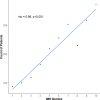The demographics and geographic distribution of laboratory-confirmed Lyme disease cases in England and Wales (2013-2016): an ecological study
- PMID: 31362976
- PMCID: PMC6677960
- DOI: 10.1136/bmjopen-2018-028064
The demographics and geographic distribution of laboratory-confirmed Lyme disease cases in England and Wales (2013-2016): an ecological study
Abstract
Objective: Lyme disease is a tick-borne disease of increasing incidence and public concern across the Northern Hemisphere. However, the socio-demographics and geographic distribution of the population affected in England and Wales are poorly understood. Therefore, the proposed study was designed to describe the demographics and distribution of laboratory-confirmed cases of Lyme disease from a national testing laboratory.
Design: An ecological study of routinely collected laboratory surveillance data.
Setting: Public Health England's national Lyme disease testing laboratory.
Participants: 3986 laboratory-confirmed cases of Lyme disease between 2013 and 2016.
Results: In England and Wales, the incidence of laboratory-confirmed Lyme disease rose significantly over the study period from 1.62 cases per 100 000 in 2013 to 1.95 cases per 100 000 in 2016. There was a bimodal age distribution (with peaks at 6-10 and 61-65 years age bands) with a predominance of male patients. A significant clustering of areas with high Lyme disease incidence was located in southern England. An association was found between disease incidence and socioeconomic status, based on the patient's resident postcode, with more cases found in less deprived areas. Cases were disproportionately found in rural areas compared with the national population distribution.
Conclusions: These results suggest that Lyme disease patients originate from areas with higher socioeconomic status and disproportionately in rural areas. Identification of the Lyme disease hotspots in southern England, alongside the socio-demographics described, will enable a targeted approach to public health interventions and messages.
Keywords: England; Lyme disease; epidemiology; laboratory; lyme borreliosis; surveillance.
© Author(s) (or their employer(s)) 2019. Re-use permitted under CC BY. Published by BMJ.
Conflict of interest statement
Competing interests: None declared.
Figures




Similar articles
-
Characteristics and patient pathways of Lyme disease patients: a retrospective analysis of hospital episode data in England and Wales (1998-2015).BMC Public Health. 2019 Aug 15;19(1):931. doi: 10.1186/s12889-019-7245-8. BMC Public Health. 2019. PMID: 31412819 Free PMC article.
-
Lyme disease in Ukraine in 2000-2023.Przegl Epidemiol. 2024 Dec 31;78(4):375-380. doi: 10.32394/pe/195666. Epub 2024 Dec 13. Przegl Epidemiol. 2024. PMID: 40101003
-
Surveillance for Lyme Disease - United States, 2008-2015.MMWR Surveill Summ. 2017 Nov 10;66(22):1-12. doi: 10.15585/mmwr.ss6622a1. MMWR Surveill Summ. 2017. PMID: 29120995 Free PMC article.
-
Epidemiology of lyme borreliosis.Curr Probl Dermatol. 2009;37:31-50. doi: 10.1159/000213069. Epub 2009 Apr 8. Curr Probl Dermatol. 2009. PMID: 19367096 Review.
-
Lyme disease in Western Europe: an emerging problem? A systematic review.Acta Clin Belg. 2021 Jun;76(3):244-252. doi: 10.1080/17843286.2019.1694293. Epub 2019 Nov 18. Acta Clin Belg. 2021. PMID: 31739768
Cited by
-
Spatial and temporal heterogeneity of the density of Borrelia burgdorferi-infected Ixodes ricinus ticks across a landscape: A 5-year study in southern England.Med Vet Entomol. 2022 Sep;36(3):356-370. doi: 10.1111/mve.12574. Epub 2022 May 6. Med Vet Entomol. 2022. PMID: 35521893 Free PMC article.
-
Seroepidemiology of Borrelia burgdorferi s.l. among German National Cohort (NAKO) Participants, Hanover.Microorganisms. 2022 Nov 17;10(11):2286. doi: 10.3390/microorganisms10112286. Microorganisms. 2022. PMID: 36422355 Free PMC article.
-
Regional seropositivity for Borrelia burgdorferi and associated risk factors: findings from the Rhineland Study, Germany.Parasit Vectors. 2022 Jul 4;15(1):241. doi: 10.1186/s13071-022-05354-z. Parasit Vectors. 2022. PMID: 35786209 Free PMC article.
-
Epidemiology of Lyme borreliosis based on outpatient claims data of all people with statutory health insurance, Germany, 2019.Euro Surveill. 2022 Aug;27(32):2101193. doi: 10.2807/1560-7917.ES.2022.27.32.2101193. Euro Surveill. 2022. PMID: 35959689 Free PMC article.
-
Lyme disease in UK primary care: a knowledge, attitude, and practice survey.BJGP Open. 2025 Apr 24;9(1):BJGPO.2024.0092. doi: 10.3399/BJGPO.2024.0092. Print 2025 Apr. BJGP Open. 2025. PMID: 39467634 Free PMC article.
References
-
- National Institute for Health and Care Excellence. Lyme disease NICE guideline [NG95]. 2018. https://www.nice.org.uk/guidance/ng95 (Accessed 23 Oct 2018).
Publication types
MeSH terms
LinkOut - more resources
Full Text Sources
Medical
